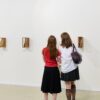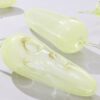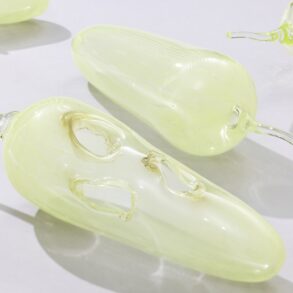
Art experts have criticised Mona’s admission that the gallery hung fake Picassos as “childish” and “unprofessional”, warning it may leave the public feeling “betrayed or hoodwinked”.
Tasmania’s Museum of Old and New Art revealed on Wednesday that the Picassos hung in women’s toilets as a protest were in fact painted by the museum owner’s wife, artist Kirsha Kaechele.
Art experts approached by the Guardian say Mona’s actions are more prank than performance art, and that it is time for the enfant terrible of the Australian art world to grow up.
“The entire episode is childish, unprofessional, and reflects poorly on Mona,” art critic and author of Inside the Art Market, Christopher Heathcote, says.
“What is being passed off as an art activist statement is the standard excuse used for attention-seeking sensationalism.”
Nine’s art critic John McDonald says: “This time, they may have outsmarted themselves.
“It’s all very well for the artist to go online and make like it was all a big joke … but I think that the general public are going to feel like they’ve been cheated by this. Once a museum begins to deliberately play hoaxes on its own constituents, then it’s in a parlous position, because we do actually understand the museum to be place where you’re going to see things which have some kind of market authority and authenticity.”
When Kaechele posted a video of the “Picassos” hanging in the female toilets, the Guardian began to ask questions. Two emails and three phone calls to the museum questioning the veracity of the artwork were ignored. Then on Wednesday the museum contacted the Guardian, saying the artist was planning to make a full confession later that afternoon.
Kaechele’s statement, titled Let Me Explain, was sent to the Guardian prior to the artist going public.
The female toilets weren’t the first home of the fake Picassos. Kaechele has admitted she created the works more than three years ago, when she installed the Ladies Lounge at Mona, a women-only space. After a court challenge from a man denied entry to the lounge, in May this year, Tasmania’s civil and administrative tribunal ruled that the installation was discriminatory. Rather than admit men, Kaechele closed the lounge, turned a couple of the museum’s unisex toilets into female-only amenities, and moved her artwork in.
Mona is appealing against the decision in the supreme court.
In her defence at the tribunal, Kaechele argued that men’s experience of the Ladies Lounge – that is, the feeling of exclusion – was part of the work. It was a feminist statement, the artist said, about centuries of women’s exclusion from certain public spaces.
The complainant, Sydney man Jason Lau, argued he paid his $35 to visit Mona like everyone else, and that his exclusion from part of museum on the basis of gender was discriminatory.
Women paid $250 each to take high tea in the Ladies Lounge, where they were pampered by male butlers and viewed “priceless” works of art in a male-free environment.
“It’s been an amusing story up until now,” says veteran art critic Elizabeth Fortescue.
“Kirsha is obviously a very skilled provocateur … but I feel very uncomfortable about her admission that she’s faked these Picassos and put them on display in a museum.
“It wouldn’t surprise me if the public felt betrayed or hoodwinked in this case, they might feel that Mona has tried to make them feel silly.”
In Kaechele’s lengthy statement issued on Wednesday, she singled out reviewers of the Ladies Lounge from the BBC, the New York Times and Traveller, delighting in how easily such esteemed publications fell for the ruse.
“But there is an expectation of trust in a museum and an assumption that curatorial ethics [are] in place,” Fortescue says.
after newsletter promotion
“There’s a kind of sacrosanct quality to museums, they put so much effort into integrity, into provenance, into protocols, into providing the public with the genuine article into which a lot of scholarship has usually happened. In light of all that, I think it was very ill-advised of her to do what she did, fake up a Picasso and not come clean at the time, three and a half years ago.”
The chair of art history at the University of Sydney, associate professor Donna Brett, says while many of her colleagues are in agreement that Kaechele’s actions were “problematic” and “just a little bit juvenile”, it was important to keep in mind that no laws had been broken.
The Picassos are fake, but no art fraud has been committed because the artist did not attempt to create false provenance for the works, nor did she attempt to sell them.
“Mona is renowned for being sensationalist, and I suppose in many ways that’s its raison d’etre … but in terms of ethics, I’ll be interested to hear what the Picasso Foundation actually has to say about it, because they take these things incredibly seriously.”
In a statement provided to the Guardian, the Paris-based Picasso Administration said after it issued a “please explain” to Mona, the museum expressed its regrets and declared itself ready to withdraw the paintings.
“While we can only regret this situation and the current overexposure, we believe that this matter is now closed,” the statement said, adding that although the institute bore no grudge against Mona or Kaechele, the museum needed to keep in mind that intellectual and creative property laws applied to everyone.
“Mistakes are also part of learning and we have no doubt that in the future Mona will ensure to work with creators when necessary,” the statement said.
McDonald believes Mona has delivered a crushing blow to its own international standing in the art world.
“A museum can’t do this kind of thing and expect to maintain much respect from people around the world,” he says.
“If this sort of thing became a practice which was just generally accepted, the entire basis of trust in museums, public and private, would be destroyed. Mona may think it’s a great joke, Mona may think it’s a very subversive act, but what they’re subverting is their own audience.”
Heathcote says Mona’s action could have a serious impact on the state’s domestic and international tourism industry. Mona is listed among the top 10 attractions on multiple websites, including the Tasmanian Government’s Discover Tasmania and Lonely Planet.
“You don’t travel from overseas or interstate only to be shown fake Picassos,” says Heathcote. “This is serious and will impact tourism.”
Mona and Tourism Tasmania did not respond to the Guardian’s request for comment.
This post was originally published on this site be sure to check out more of their content








